 |
- OTHER SERVICES VOICES:
- MARINES
- •
- NAVY
- •
- AIR FORCE
- •
- ARMY
- •
- COAST GUARD
|
An up close and personal interview with U.S. Navy Veteran and TWS Member:
PO1 Daniel Galvin, Jr (US Navy 1940-1951)
WHAT PERSUADED YOU TO JOIN THE SERVICE?
In August 1940, when I first saw a neighbor dressed in his Navy Uniform, I thought he was really changed. Also the draft was coming in a month or so since the Nazis were on the move into adjacent countries. I remembered my father was in the U.S. Army in WW I. I did not want to live in the mud as he did and have short rations most of the time. It was my opinion that the fellows that waited would have the least training and to save experienced troops the new arrivals would be used as "Cannon Fodder," so I decided to join the Navy. I enlisted at the old Boston Post Office and got on the bus with some other enlistees to Boot Camp in Rhode Island. One note of interest is that when I was about to sign for 4 years an Officer scratched out the 4 and changed it to 6 years. He was right; when the war ended I had only a month or so left in my enlistment.
BRIEFLY, WHAT WAS YOUR CAREER PATH?
Upon boarding the USS Quincy (CA-39) I was assigned to the 4th Division, a deck Division. I was a real "Swabby," I used the "Holy Stone" to my advantage making the deck planks turn snow white. I was soon interviewed by Lt. Good concerning changing to another division. I believe he had seen my record, which showed that I had some College training and he really perked up when he was told how much I loved Trigonometry. He asked if I would like to transfer to the F Division and when I asked what they did he told me that they control the Ship's gun fire. I thought that was great so I signed up for the transfer. My two years on CA-39 allowed me to advance to Firecontrolman 3rd class. After surviving the battle of Savo Island, I was transferred to the USS Cascade (AD-16) where I learned so much about how electro-mechanical instruments worked that my civilian career after the Navy was guaranteed.
DID YOU PARTICIPATE IN COMBAT OPERATIONS?
The USS Quincy did two tours in the North Atlantic from 1940 to 1942, in Iceland. During that time the ship was photographed in company with British Battleships by high altitude German aircraft. About that time there were some German Battleships missing from their anchorage in Norway, so the Quincy was sent in search of them. We had special cold weather clothing for that assignment and the watches were reduced to 2 hours instead of the usual 4 hours. We headed North, past the icebergs, until we reached solid ice. Once there our Scout Observation Curtis [SOC] aircraft were warmed up and launched to fly over the ice to look for possible breaks therein. When that mission concluded, we were heading back to Iceland when we were torpedo attacked by a German Submarine. Our Captain caused an abrupt turn to port which caused the torpedo to miss. Later, while accompanying several American transports loaded with British Troops traveling from Halifax, Nova Scotia to Capetown, South Africa we were confronted on the surface by the largest French submarine in their fleet. This boat had a twin gun turret forward of the conning tower and an aircraft hanger aft. We had no idea who was on board, whether it was free French, Quislings, or Nazis so we passed with our turrets aimed at each other, that was a sobering experience.
When we were one day out of Capetown I heard the ship's PA system announce "Japanese forces have attacked Pearl Harbor - we are now at war with the Empire of Japan!" After our return to the States we berthed in the Brooklyn N.Y. Navy Yard for extensive upgrading of the ship's armament. Our next assignment was in support of the invasion of the Japanese held Island of Guadalcanal. The USS Quincy had the honor to fire the first offensive shots at the Japanese military on August 7, 1942. We were under air attack by high level bombers, dive bombers, and torpedo planes during the first 2 days of the operation. In the early hours of the 3rd day we suffered a terrible onslaught by 7 Jap cruisers which attacked with torpedoes and gun fire at very close range. Sometime after midnight, as August 8th turned into August 9th, the Quincy and two other cruisers, the USS Vincennes and the USS Astoria, were sailing off Savo Island. I was at my battle station in Sky Forward, atop the ship, when I saw something in the darkness - I realized they were Japanese warships just as they sky exploded. Their first salvos were star shells, used to illuminate the target.
The eerie beauty of the star shells gave way to deafening shelling. Everything around me exploded, the bridge blew up and I knew the Captain was dead. I slid down the ladder from Sky Forward just as the torpedoes slammed into the hull. I felt something hit me in the chest but it was pitch black so I didn't know what it was but I grabbed hold of it anyway. It was a life preserver that somebody was handing out and I got one by chance. Within minutes, the ship was listing 45 degrees and then she rolled over. I was running down the hull on the starboard side and I could hear my feet ping on the metal, I think I was probably the last guy off.
The Quincy sank in less than 10 minutes; the Vincennes and the Astoria were sunk too. Once in the water I heard someone calling out, "come over here!" It was my buddy Clyde Bolton and so I yelled back at him "You come over here," as I struggled to stay afloat. We were about 50 feet away from each other but I had no way of knowing that he was badly burned and needed help to stay afloat - sadly he drowned that day.
By dawn I had been in the water for five hours before I was able to make my way up the rope ladder on to the USS Ellet. I was so exhausted and with waterlogged clothes that I had to be dragged the last few feet. I was numb even before I found out that nearly half of the 800 men on the Quincy were killed. I don't think that I had PTSD, but I definitely have a form of survivor's guilt, I feel like I shouldn't be here. Clyde Bolton got the ship job that I wanted and he died. Ralph Beebe took the job below deck that I had turned down and he died as well. I also found myself floating with a life preserver while men sank around me. I should have gone over to Clyde when he called me. I think about him every day and I wish I had swam over to him.
It is my opinion that in 1942 the United States Navy was essentially a "Peacetime Navy," and the ships were very poorly equipped for battle. The sailors did not have helmets or dog-tags, and they were not trained to fight in "close quarters" with the enemy. Historically speaking, the US Navy's previous battles were fought "horizon to horizon" and during the day. The Japanese Army and Navy fought in close proximity (within 100 yards) and the Japanese ships were equipped with torpedoes and fought battles at night. At the time of this battle, we simply were not prepared for them.
The Battle of Savo Island was the first U. S. Naval battle with the Japanese Navy in WWII and although this battle was a massive defeat for the United States Navy, it should in no way reflect the readiness and bravery of the men who fought in it. It is my mission to make sure that my shipmates who died on August 9, 1942 are never forgotten.
FROM YOUR ENTIRE SERVICE CAREER WHAT PARTICULAR MEMORY STANDS OUT?
All my experiences related to the sinking of the USS Quincy outlined above.
WHICH INDIVIDUAL PERSON FROM YOUR SERVICE STANDS OUT AS THE ONE WHO HAD THE BIGGEST IMPACT ON YOU...AND WHY?
For me that would be Lt. Good. He was the individual that listened to me carefully when he asked about my preferences. The simple fact that he listened and gave me assignments that I requested has allowed me to be alive to this day. He was transferred from the Quincy while we were in New York, and I have no idea where he was assigned after that.
WHAT PROFESSION DID YOU FOLLOW AFTER THE SERVICE AND WHAT ARE YOU DOING NOW?
The 3 years that I spent on the USS Cascade (AD-16), without a liberty, gave me a massive education in the design and functioning of Electro-mechanical instrumentation. Since the ship was a Destroyer Tender, I had exposure to the inner workings of Fire-control equipment. In fact, I received a Navy Commendation Medal from Admiral Chester Nimitz for repair work not usually done at sea. As a civilian, initially employed by the Massachusetts Institute of Technology, I was responsible for the Electro-mechanical design of 10 Plasma Probes that went into space to monitor the intensity of particle radiation from the sun. I also worked on an inter-galactic Gamma Ray Telescope that was also launched into space. I was retired after 20 years of service to MIT and I was then recruited by a head-hunter that asked if I wished to return to space work. I was hired by Avco, later known as Textron, which had a contract to design and build the MX Missile system. My work involved the design of the deployment module which was my biggest challenge to date since it was the first time I worked on a mechanism that would be pressurized in space. I was also responsible to design the Power Distribution and Signal Conditioner (PDSC) of the Reentry Vehicle, i.e., the Atomic Bomb. The first test of the missile was a flight from Vandenburg Air Force Base in California to Eniwetoc in the South Pacific. This was the first successful test of a new American Missile at that time. It's interesting that a Russian ship was present recording our telemetry as the 10 reentry vehicles were deployed. My relief from the stress of the design of this weaponry came with the successful 10th shot and when the Berlin Wall came down. When the wall fell the Russians had quit the race for Supremacy and the tension was over.
How has serving in the Navy influenced the way you now approach your life and career?
The absolute control the military had over my life, my decisions, my needs, etc., in the long run taught me very firm control over my personal decisions as a civilian. From the information that I have revealed in this interview it is obvious that I continued to assist the United States of America to advance in the areas of space exploration and in the advancement of Military Weapons for the Air Force. I believe that my country and I have both benefited by this life-long partnership. I have tried to forgive my failure to respond to my dying friend Bolton by accomplishing something that I might be proud of.
HOW HAS TOGETHERWESERVED.COM HELPED YOU TO MAINTAIN A BOND WITH THE SERVICE AND THOSE YOU SERVED WITH?
I have only been a member of TWS for a month or so, and I'm just beginning to make contacts with others who served during my time. Since I am 1 year from reaching 90 most of the men I served with in WWII have passed or are handicapped. This coming September my dear wife and I hope to attend a reunion of the crew of USS Cascade (AD-16) in Chicago. These men served on the ship in other wars but accept me as a Shipmate for which I am grateful. | 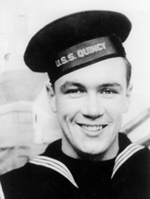
PO1 Daniel Galvin, Jr
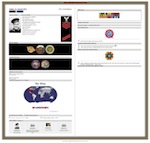
View PO1 Daniel Galvin's Shadowbox on TWS
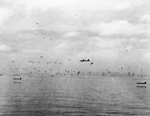
Japanese bombers attacking the USS Quincy
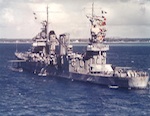
USS Quincy CA-39
|
|
Share this Voices on:


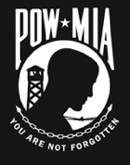

|
|
TWS VOICES
TWS Voices are the personal stories of men and women who served in the US Military and convey how serving their Country has made a positive impact on their lives. If you would like to participate in a future edition of Voices, or know someone who might be interested, please contact Major Wesley Prater HERE.
View the Complete Togetherweserved Voices Archive HERE
This edition of Navy Voices was supported by:
NAVY.TOGETHERWESERVED.COM
For current and former serving Members of the United States Navy, TogetherWeServed is a unique, feature-rich resource enabling Naval personnel to re-connect with lost Shipmates, share memories and tell their Navy story.
Click HERE if you need a password reminder for http://Navy.togetherweserved.com.
|
|